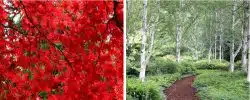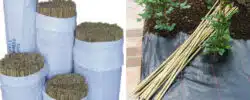How to Plant a Hedge
You are here: Home »

We have written a series of handy guides giving straightforward and easy to follow guidance covering site preparation, planting, protection and aftercare for all of the hedging types that we sell. You can read the whole general guidance here or use the links at the bottom of the page for specific guidance for bare root, rootball, pot grown and instant hedging types, as well as beginner guides to hedging. If you still have any questions please do not hesitate to give our experienced team a call on 01580 765600, they will be pleased to help. Planting a new hedge is a satisfying pastime so happy planting!
Planting guidelines for new hedges
Preparing the site for planting
Do try to get the site ready before your plants are delivered, this way you will be able to plant more easily and quickly especially if the weather is bad after delivery. Planting quickly after delivery is a certain insurance against your hedging plants deteriorating and will without doubt give the best results.
It is very important to remove all perennial weeds and grass from the planting area which should be thoroughly dug over as a trench to at least 20cm (8 inches) deep for smaller plants (up to 60/80cm tall), 30cm deep for larger plants making sure that the sides and bottom have good drainage, loosening with a fork if necessary.
A new hedge needs to have a trench (or individual holes if you prefer) large enough so the roots can spread out naturally, surrounded by well-prepared soil they can grow into and establish, not have their root system squeezed into the smallest possible hole. Preparing thoroughly now can be time consuming but is still much easier than trying to remedy problems after planting so is time very well spent.
If you have a lot of perennial weeds it might pay to use a systemic weedkiller such as ‘Roundup’ (kills the roots as well as the leaves of weeds) a week or two before preparing the site following the recommendations on the pack.
The width of your prepared ground will depend on the size of plants, and whether you are planting a single or double row. Here are some rough minimum guidelines you might find useful but if in doubt, go a little wider, especially for bushy root ball plants like laurel and privet.
Single row hedge planting
Plants up to 60cm tall in a single row – prepare a strip at least 30cm wide.
Plants up to 120cm tall in a single row – prepare a strip at least 40cm wide.
Plants up to 200cm tall in a single row – prepare a strip at least 50cm wide.
Plants over 200cm tall in a single row – prepare a strip at least 60cm wide.
Double row hedge planting
Plants up to 60cm tall in a double row – prepare a strip at least 50cm wide.
Plants up to 120cm tall in a double row – prepare a strip at least 60cm wide.
Plants up to 200cm tall in a double row – prepare a strip at least 70cm wide.
Plants over 200cm tall in a double row – prepare a strip at least 80cm wide.
It is possible to prepare the site with a mini digger which can save time but some heavy soils can smear or compact sealing the edges and bottom of the trench trapping water which will kill the roots. Extra attention to loosening the sides and base with a hand fork will be needed and care needs to be taken not to mix poor quality subsoil with your topsoil. If the site is very wet the mini digger will almost certainly compact the soil (as well as making a very muddy mess!) so its better to either wait for drier weather and improved conditions, or do the work by hand.
The same principles apply to using an auger to make the planting holes, it’s a great idea if you have a lot of planting to do and can save a lot of time – but the hole must be big enough so the roots can spread out naturally, there must be space for a backfill of loose soil around the roots and the sides and base of the hole must be loosened before planting to allow drainage – otherwise you will have a row of sealed/compacted sump holes and very poor success rate. Don’t let us put you off, just be aware that these small details can make a very big difference to the end result.
Unless your soil is already good, it will pay to improve it by adding organic matter like well-rotted manure, garden compost or general planting compost/soil improver which should be well mixed in with the surrounding soil. Poorly drained planting sites always benefit from having some sharp sand or grit added in the same way, planting on a slightly raised mound can also help on wet sites, or adding perforated drainage pipe to get rid of excess water.
Rootgrow and bone meal
The best fertiliser to add is bone meal, an organic slow releasing feed as this encourages root growth which is essential to get your hedge established, as a guide 1 kilo will be enough for about 15 metres of hedge planting on a single row. It is important that bone meal does not come into direct contact with plant roots as it will scorch them, make sure the bone meal is well mixed with the soil and water well a day or so before planting if it is very dry.
We recommend using Rootgrow when you plant new hedging of all types, this is a really useful product endorsed by the RHS, an easy to apply product containing native mycorrhizal fungi that colonise plant roots greatly increasing the availability of water and nutrients to your new hedge. This means new hedges of any species will establish far more quickly, this can be especially important with bare root and rootball evergreen hedging plants that are vulnerable to losing moisture through their leaves after planting, particularly in the warmer spring months. Unlike bone meal, rootgrow should be in direct contact with the plant roots to colonise them as quickly as possible. Rootgrow should be sprinkled into the planting hole or trench directly next to the roots, all except the smallest packs come with a gel sachet that is mixed with water and can be applied as a paste to the roots of bare root plants.
Planting
If possible do try and avoid planting if the ground is frozen, or immediately after very heavy rain as the soil can compact easily when very wet which will then make it difficult for the roots to establish. If it is very windy do protect the roots of your plants leaving them exposed to the wind for the shortest possible time.
Planting pot grown hedging
Pot grown hedging can be planted at any time, unpack them as soon as possible after delivery and stand them out in a sheltered area if you aren’t planting immediately.
Make sure they are well watered, remove the pot and plant into the soil you have prepared, backfilling in around the root ball with well worked fine soil and settling them in with a firm but gentle hand pressure or heel of your boot while holding the top of the plant to keep it straight. After planting the compost surface should be just covered in soil to prevent the root ball drying out. Water the plants well when you have finished planting. Tall plants may need staking or supporting to prevent the wind dislodging them.
Planting Root Ball hedging
Unpack your root ball plants and aim to plant them as quickly as possible after delivery (especially later in the season – March and April). If you are not planting immediately they can be stored in a protected place away from drying winds and kept well-watered for a few days, this can be in a sheltered spot outside or in an unheated shed or garage (but not a greenhouse)
Root ball plants will usually need a deeper and wider trench than other types of hedging as they can have substantial root systems. Make sure the sides and bottom of the trench have been loosened with a fork to allow drainage and remove any compaction and give the newly emerging roots a foothold.
If the planting site is very dry it should be well soaked before planting allowing time for the excess to drain away. PLEASE DO NOT REMOVE THE HESSIAN MESH around the roots when planting, it is there to protect the roots and will rot away completely over time, although once the plant is in position the tie around the stem can be loosened or cut (but only when you have placed the plant in position, started to backfill and the plant won’t need to be moved again). Root ball plants will have a ‘nursery mark’ on the stem, this is where the soil level was when they were growing here on the nursery. Always make sure to plant them back at the same depth. Backfill the trench around the root ball which should then be well firmed without compacting it to remove any air pockets being sure to hold onto the plant as you firm to keep it straight.
After planting water the new hedge thoroughly – as a guide for evergreens, 5 litres for each smaller plant (under 1 metre), 10 litres for each medium plant (1 to 2 metres) and 20 litres for each large plant (over 2 metres).
This will need to be repeated once or twice a week in dry weather especially for Thuja, Laurel and Privet root balls. If in doubt check how wet the soil is a few inches under the surface. If it is very dry you need more water, just moist them you are watering correctly, if it is very wet and sticky then cut back.
There are many variables here, different sizes and species will use differing amounts of water, and different soil types will need water more or less frequently, planting at the end of the season (March and April) will leave un-watered plants much more vulnerable than the same plants planted earlier in the season. The golden rule is to ‘stay in tune’ with your hedge, check the soil regularly a few inches down, not just on the surface and observe the plants – if the leaves start to flag then they almost certainly need water.
Planting bare root hedging
Bare root plants are sent out to you with the roots wrapped and then enclosed inside protective sleeving or boxes. They can be kept somewhere sheltered (such as an unheated but frost free shed or garage – but not a greenhouse) in their packaging for a few days
Heeling in
Bare root plants can be kept for much longer by ‘heeling in’ or planting them after unpacking, in their bundles in prepared fine soil (for example in the corner of a vegetable patch or flower bed) being sure that the roots are well covered with soil to prevent them drying out or frost getting to them. If you do heel in be sure to plant them in their final positions in good time, certainly by the end of March at the very latest, sooner if you can. Bare root evergreen hedging can be heeled in but the plants can be susceptible to mould (and drying out) if left for long, if you do heel them in try to get them planted within a week, two at the most. Deciduous plants can be left heeled in for weeks, or even months as long as they are planted out before they come into leaf.
When you come to plant, start by soaking the roots in water for up to an hour (but no longer as this will starve the roots of essential oxygen). Plant them into your prepared trench or individual holes adding Rootgrow gel at this stage if desired, they should be planted with enough space to allow the roots to spread out naturally and then backfilling with well prepared soil. Bare root hedging plants will have a ‘nursery mark’ on the stem where the soil level was when they were growing on the nursery. Always ensure that you re plant them back at the same depth firming the soil in around the roots as you backfill to remove air pockets – firmly but gently, holding the top of the plant as you do it to keep them straight. Taller plants may need support or staking, especially on windy and exposed planting sites.
Slit planting bare root hedging plants
Smaller deciduous bare rooted plants can also be planted by the slit method, especially if you have a lot of hedging to plant. Using a sharp spade pushed in to almost full depth, move the handle away from you while the spade is still in the ground to reveal a slit in the soil. The roots are then inserted into the slit and the spade is then released while still holding onto the plant, and then removed carefully so as not to pull the roots back out of the slit. The plant is then firmed with the heel of your boot to prevent the plant being dislodged. This method of planting is much faster but the possibility of a higher failure rate must be accepted (you can compensate for this by using more plants per metre which shouldn’t be too expensive with small plants).
Slit planting is at its most successful when the site has been sprayed off with systemic weedkiller some weeks before, planting is carried out before mid-March and a generous mulch is applied straight after planting to stop new weeds growing. In reasonable soil, this can give very good results at comparatively low cost.
Planting instant hedging plants.
Instant hedging plants are always delivered on a pallet because of their size, they can be left on the pallet for a day or two making sure they are kept well-watered. The ground should be prepared in a trench as with other types of hedging, the size of trench will depend on the type of instant hedging you have ordered
Standard troughs – prepare a trench at least 20cm deep and 25cm wide to allow for backfilling, making sure the base and sides of the trench have been loosened with a fork. The trough itself is approx. 17cm wide and 17cm deep.
Maxi troughs – prepare a trench at least 25cm deep and 30cm wide to allow for backfilling making sure the base and sides of the trench have been loosened with a fork. The trough itself is approx. 20cm wide and 20cm deep.
Large troughs – prepare a trench at least 35cm deep and 40cm wide to allow for backfilling making sure the base and sides of the trench have been loosened with a fork. The trough itself is approx. 30cm wide and 35cm deep.
Extra large troughs and Hedge elements – prepare a trench at least 35cm deep and 50cm wide to allow for backfilling making sure the base and sides of the trench have been loosened with a fork. The trough itself is approx. 35cm deep and 40cm wide.
Where the instant hedging is supplied in a plastic trough, this should be removed before planting sitting the hedge in the trench backfilling with well prepared soil firming gently but firmly to remove air pockets while holding the top of the plants to keep them straight. When planted the compost should be just covered. Give the new hedge a really good soak after planting and continue with this twice a week until well established.
Where instant hedging is supplied in cardboard troughs (we are moving over to this system more and more on environmental grounds) – simply plant the whole thing including the cardboard (which will help with spacing as they simply butt up to each other) making sure to plant with the compost level and cardboard just covered with soil. Give the new hedge an extra good soak making sure the cardboard is saturated too (it will rot away in as little as a month provided it is wetted) and keep watering thoroughly twice a week until the new hedge is well established.
Mulching
A mulch is a layer of organic matter such as bark chips, garden compost or similar material that is applied to the surface of the soil around your new hedge (but not touching the stems) to supress weeds and conserve moisture. We strongly recommend mulching new hedges to improve the success rate and vastly improve growth in the first year or two, especially on lighter soils that don’t retain moisture. Mulching is still a great idea on heavier soils that can dry out and crack on the surface in dry spells for most plants except for Box and Yew and Lavender where too much moisture can be trapped making these species more susceptible to root diseases. A mulch should be applied at least 5-8cm deep (2-3 inches) deep and at least as wide as the strip you have prepared. Mulching should be carried out as soon as possible after planting and before weed seedling appear, watering very well beforehand if the soil is dry.
Aftercare
The first summer after planting is the most critical time for a newly planted hedge, it really is essential that new hedges have enough water, light and nutrients to establish and grow away well. They must be kept free of all weeds including grass over the whole width of the planting area (even the short grass of a lawn will compete for moisture and nutrients) for at least the first 2 years. New hedges need to be kept well-watered if the weather is dry, especially evergreen rootball plants and larger potted hedging. As a guide, a new hedge will need at least 5-10 litres per metre of hedge, twice a week but larger rootball plants will need substantially more. Evergreen hedging plants also appreciate misting over the leaves which like all watering should be done in the evening when the heat of the day has passed.
Late into leaf
In the first season after planting a new hedge will almost always come into leaf much later than an established hedge of the same species. Bare root plants need to establish new roots before coming out of dormancy and need a close eye kept on watering, especially as the new leaves emerge.
Many evergreen plants, (especially bare root and rootball hedging plants) will ‘moult’ or defoliate many leaves, or the leaves may turn yellow following warm weather (this can happen very quickly). This is a perfectly normal response from the plant trying to conserve water while establishing new roots. With good care and watering, new shoots will emerge a few weeks later and the plants will catch up.
The best way to minimise these effects is to do everything possible to encourage a new strong root system – good soil preparation, applying bonemeal, using Rootgrow, keeping the area completely free of weeds and grass, mulching and watering regularly and sufficiently. Windbreak netting can also be useful to protect new bare root hedging plants from drying out excessively. Well-tended plants will grow away more quickly and will tend to resist pests and diseases.
Rabbit protection
Rabbits can cause serious damage to new hedges, if you have a rabbit problem there are three options:
- Plant species that rabbits don’t eat (Box or Yew)
- Use spiral tree guards to protect the stems, smaller plants will need a 90cm bamboo cane to support the plant and the guard.
- Multi stemmed or bushier plants will need either circles of wire netting for the individual plants supported with a small stake, or the whole area secured with rabbit netting.
Other animals can also cause damage so please do check your new hedge regularly.
Wind rock
Strong winds (even moderate breezes) can cause newly planted hedging plants to rock and sway opening a hole around the stem that can then fill with water which will eventually kill the plant. Really strong gales can even dislodge plants to the point that the roots become exposed which is also fatal. Check your new hedge regularly and re firm plants where necessary until they are well established. Straightening up a newly planted hedge is much easier than trying to take remedial action when they have grown much larger. Taller plants may need staking, particularly on windy and more exposed sites where (firmly supported) windbreak netting may also be useful.
Trimming and pruning
Most hedging plants do not need pruning after planting except for quickthorn, blackthorn and bare root privet and laurel which can be cut back by between a third and a half of their height to make them really bushy from the start. Other deciduous hedging can be lighly ‘tipped’ after planting also removing any damaged or wayward stems.
In the following years deciduous hedges will make a denser hedge more quickly of the annual growth is shortened slightly. Most evergreens will not need trimming until the second year onwards when the sides can be lightly clipped to shape as required. Give the top of your new hedge its first trim just short of the proposed final height as this will make it fill out.
As a rule, deciduous hedges can be trimmed in mid to late summer while evergreen hedges are best trimmed in early spring or early autumn but there are always exceptions, recommended timings for trimming all hedge species can be found on our website or in our catalogue.
Looking after your established hedge.
Most of the work is done by the time your plants have established and ‘filled out’, it should then be healthy and growing strongly. To maintain this, we recommend an annual feed and mulch in spring keeping the hedge in tip top condition. Read our guides on How To Make Your Laurel Grow Faster and Common Pests Diseases and Problems with Laurel Hedge Plants for more information on getting the best out of your Laurel Hedging Plants




















































